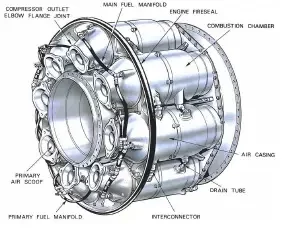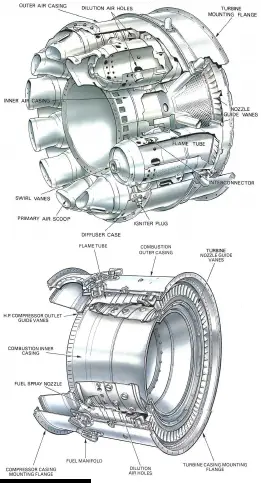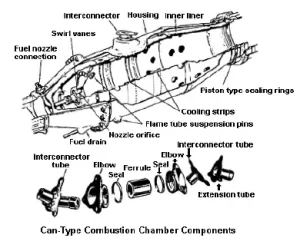Gas turbine combustion chamber
Gas Turbine Combustion Chamber
The gas turbine combustion chamber is a vital component within a gas turbine engine. It’s here that the engine transforms chemical energy into mechanical energy. This is achieved through a precise process of fuel combustion and heat transfer.
Key Functions gas turbine combustion chamber
- Fuel-Air Mixing: The chamber meticulously mixes fuel (such as natural gas or jet fuel) with compressed air to form a combustible mixture.
- Ignition: A spark or pilot flame ignites the premixed fuel and air, initiating the combustion process.
- Combustion: The ignited mixture undergoes rapid oxidation, releasing a substantial amount of heat energy.
- Heat Transfer: The intense heat generated during combustion is transferred to the turbine blades, causing them to spin and produce mechanical work.
Different types of combustion chamber and turbine
- Multiple can type combustion chamber
 This type of combustion chamber isused on centrifugal compressor type engines. It has several cans disposed around the engine. Each can is acomplete combustion chamber consisting of its own air outer with aflame-tube (or burner liner) inside.Compressor delivery air is directed byducts to pass into the individual chambers. Each can contain its own fuel nozzle.The chamber cans are all interconnected. This allows each can to operate at the same pressure and also allows combustion to propagate around the flame tubes during engine starting. Igniter plugs are installed on two of the cans approximately at 4 and 5 o’clock positions.
This type of combustion chamber isused on centrifugal compressor type engines. It has several cans disposed around the engine. Each can is acomplete combustion chamber consisting of its own air outer with aflame-tube (or burner liner) inside.Compressor delivery air is directed byducts to pass into the individual chambers. Each can contain its own fuel nozzle.The chamber cans are all interconnected. This allows each can to operate at the same pressure and also allows combustion to propagate around the flame tubes during engine starting. Igniter plugs are installed on two of the cans approximately at 4 and 5 o’clock positions.
2.Turbo annular combustion chamber Can-annular

3.Annular combustion chamber
Materials and Contsruction
Multiple combustion chambers
Multiple combustion chambers in gas turbines, primarily used in can-type and can-annular designs, are typically constructed using a combination of high-temperature alloys and ceramic materials. The outer casing is often made of a strong, heat-resistant alloy like Inconel or Incoloy, while the inner liner, directly exposed to the intense heat of combustion, is typically composed of ceramic materials like zirconia or silicon carbide. These materials are carefully selected to withstand high temperatures, thermal shock, and corrosive environments. The chambers are assembled using advanced manufacturing techniques like welding and brazing, ensuring precise alignment and leak-tight seals.
Turbo annular combustion chamber Can-annular
Turbo-annular combustion chambers, a hybrid design, combine the efficiency of annular chambers with the flexibility of can-type chambers. They typically feature an annular outer casing made of high-temperature alloys like Inconel or Incoloy, which provides structural support and containment. The inner liner, directly exposed to the flame, is often constructed from ceramic materials such as zirconia or silicon carbide, offering excellent thermal insulation and resistance to high temperatures. Individual combustion cans, made of similar materials, are arranged within the annular chamber, allowing for modular design and maintenance. Advanced manufacturing techniques like welding and brazing are employed to assemble the components, ensuring precise alignment and leak-tight seals.
Annular combustion chamber
Some provision is always made in the combustion chamber case or in the compressor air outlet elbow for installation of a fuel nozzle. The fuel nozzle delivers the fuel into the liner in a freely atomized spray. The freer the spray the more rapid and efficient the burning process. Two types of fuel nozzles currently being used in the various types of combustion chambers are the simple nozzle and the duple nozzle. The annular combustion chamber consists basically of a housing and a liner as does the can type.
The liner consists of an undivided circular shroude tending all the way around the outside of the turbine shaft housing.
The chamber may beconstructed of one or more baskets. If two or more chambers are used one is placed outside the other in the same radial plane0 hence the term double-annular chamber.The spark igniterplugs of the annular combustion chamber are the same basic type used in the can combustion chambers although construction details may vary. There are usually two plugs mounted on the boss provided on each of the chamber housings. The plugs must be long enough to protrude from the housing into the outer annulus of the double-annular combustion chamber.
Advantages and disadvantages of different type of combustion chamber
Combustion chambers in gas turbines have various designs, each offering unique advantages and disadvantages.
Can combustion chambers are known for their modularity, allowing easy maintenance and replacement of individual cans without impacting the entire system. However, they tend to be bulkier and can experience uneven heat distribution, which may affect efficiency. On the other hand,
annular combustion chambers are more compact and promote better mixing of fuel and air, resulting in higher combustion efficiency and lower pressure drops. Despite these benefits, their complex design can complicate maintenance procedures.
Mixed-type combustion chambers provide a versatile solution by combining features of both can and annular designs, optimizing fuel-air mixing and efficiency while maintaining a relatively compact size. However, they can be more complex and costly to manufacture and maintain. Reverse-flow combustion chambers stand out for their high efficiency due to a unique flow path that enhances combustion but come with the downside of increased complexity, leading to potentially higher manufacturing costs and requiring careful thermal management to prevent overheating. Lastly, dry low emission (DLE) combustion chambers excel at minimizing pollutants, making them suitable for strict environmental regulations, but their advanced technologies often result in higher costs and possible limitations in fuel flexibility and operational performance at higher loads. Each design presents a trade-off between efficiency, emissions, maintenance requirements, and overall cost, guiding the selection based on specific operational demands.
Design Features
- Annular or Can-Type: Combustion chambers are typically designed in either an annular or can-type configuration. Annular chambers have a circular shape, while can-type chambers are shaped like individual cans.
- Liner: The inner walls of the chamber are lined with a heat-resistant material to protect the metal from the extreme temperatures.
- Fuel Injectors: Fuel is precisely injected into the chamber through strategically placed fuel injectors.
- Flame Stabilizers: These components help maintain a stable flame front and prevent flashback.
- Cooling System: A cooling system is often employed to manage the high temperatures and prevent damage to the chamber.
Challenges and Considerations:
- High Temperatures: The combustion process generates extremely high temperatures, demanding materials with exceptional heat resistance.
- Emissions: Minimizing harmful emissions like NOx and CO is a constant engineering challenge.
- Efficiency: Engineers strive to maximize the efficiency of the combustion process to extract the most energy from the fuel.
Applications:
Gas turbine combustion chambers find applications in a wide range of industries, including:
- Aviation: Powering aircraft engines for both commercial and military applications.
- Power Generation: Producing electricity in power plants.
- Marine Propulsion: Driving ships and marine vessels.
- Industrial Processes: Providing power for various industrial applications.
In essence, the gas turbine combustion chamber is the heart of the gas turbine engine. Its efficient operation is crucial for the overall performance and reliability of the engine.
Regional method of introducing air Primary zone

(15-20% air)
Air is introduced around the fuel jet and burns in approximately stoichiometric ratio, so, high and, as a result, rapid combustion occurs.
Secondary zone (30% air)
It is introduced into the secondary zone through a hole in the flame tube to complete combustion. For high combustion efficiency, the air must be carefully introduced in any suitable manner and this is done because it prevents the flame from cooling to the zone and reduces the reaction rate in the environment.
Third zone (residual air)
Dilution zone
Cooling
The vortex flow is sufficient to completely mix the cold and hot streams, without hot exhausts, which may risk damage to the turbine blades.
Here are some additional keywords you could use for further research:
- gas turbine engine
- combustion process
- thermal efficiency
- NOx emissions
- turbine blade cooling




